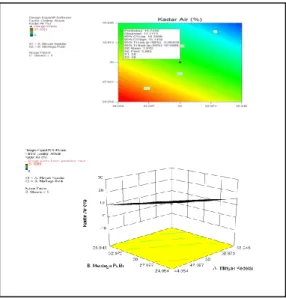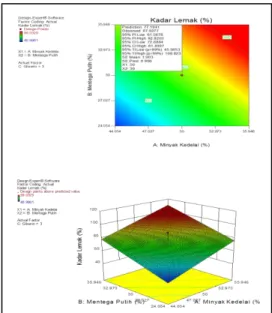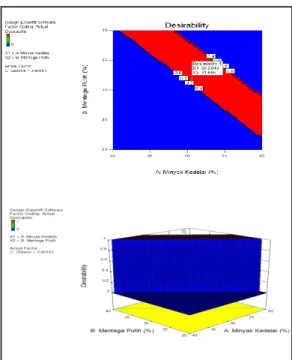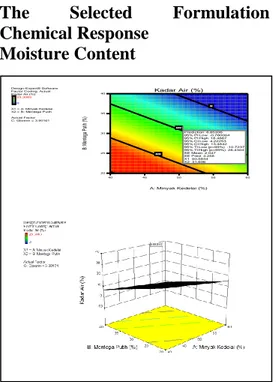1
OPTIMIZATION of SHORTENING and GLYCERIN in SOYBEAN OIL
(Glycine max l. Merril) in MAKING MARGARINE USING RESPONSE
SURFACE METHODOLOGY
Inneke Angela, Ir. Hervelly, MP., Dr. Ir. Yusman Taufik, MP. Food Technology Pasundan University, Bandung
E-mail : innekeangela@gmail.com
ABSTRACT
The objective and aimed of this study is to determine the optimal formulation in margarine produced from soybean oil, white butter and glycerin as a raw material and lecithin, tween 80, skim milk and water as supporting material and to determine the result of chemical properties from margarine soy oil.
The study consisted of two phases: a preliminary stage to determine the fixed variables and independent variables used and the second stage to determine the exact formulation of margarine using Response Surface Methodology Central Composite Design methods aimed at optimization of margarine products in accordance with the existing margarine. Responses that tested against margarine produced were the water content and fat content and organoleptic test by test description.
Based on 13 formulations offered, the value of the precision that indicates the value of 1 is the margarine with the formulation of soy oil 50.584%, white butter 31.606%, and glycerin 3.902% of the overall amount to 86.092% and the rest is fixed variables that lecithin 5%, skim milk 1, 5%, 0.5% tween 80, and 6.908% water. The formulation is predicted by the program with a response moisture content 8.853% and 82.690% fat content. Based on the description of the product test margarine, soybean oil margarine samples with sample code 474 has the lowest value compared with the margarine samples are already in the market such as palmia (363), filma (634) and forvita (743).
Keywords: Margarine, Soybean Oil, White Butter, Glycerin, Response Surface Methodology.
INTRODUCTION
In Indonesia, the average consumption nationwide reached 47.2 fat grams or 25.6 percent of total energy consumption that recommended by General Guidelines Balanced Nutrition (PUGS). This has resulted in the presence of excess cholesterol in the body that will give rise to the condition of ateroklerosis or constriction of the blood vessels. Problems ateroklerosis be the greatest health problem in many countries, both countries that have already advanced or developing countries (Astuti, 2013).
There are several ways that have been taken to reduce the negative influence due to the consumption of fat like replacing a portion of fat with fat substitutes from vegetable materials of soy beans oil (Agus, 2011).
Soybean oil is vegetable oil produced from soy beans. Soybean oil made up of triglycerides by 90% to 95%, while the rest is fosfatida, free fatty acids, sterols and tocopherols. The number of fosfatida in soybeans is about 2% consists of lecithin and sephalin. Fatty acids in soybean oil is mostly composed of fatty acids of life which is urgently needed by the body (Sulistyawati et al., 2006).
According to the Ministry of industry of INDONESIA, since 2004 the use of commodity soybean oil achieves around 25 million tons with an average growth of 3.8% per year.
In the food industry, soy oil can be used as a cooking oil, salad oil, the raw material for margarine, shortening and other raw materials. More than 50% of food products made from soybean oil, especially margarine, and almost 90% of the production of soybean oil is used in a
2 form that has been on the hydrogenation (Isa, 2011).
Margarine are products containing saturated fats. Fat provides taste and aroma specific to foods that hard to replace by other food components (Agus, 2011).
Margarine is intended as a replacement for butter with fine art, smell the consistency of taste and nutritional value is almost the same with butter. Margarine contains 80% fat, 16% water and some other substances (Shahidi, 2005).
According to Rahayuningsih (1989), the basic formula of margarine are fat or oil 80%, salt of 2-4%, water 16%, antioxidants, emulsifiers 0.2% 0.3%, coloring and flavorings to taste.
According to Weiss (1983), the addition of white butter (shortening) in the batter can give a soft texture and rich flavor, add keempukan and prevent the occurrence of aeration to maintain moisture and increased size.
According to Winarno (2008), the use of emulsifiers as Glycerin is to maintain the stability of the emulsion on the product. The nature of Glycerin that is has the ability to bind water. In addition the Glycerin can give you the texture that wasn't so hard on half-wet food.
According to the Lestari (2010), research done in the manufacture of margarine fish Catfish are plastis margarine's texture is obtained in comparison to pure fish oil and stearin catfish by 60:40 while by comparison 40:60 and 50:50 margarine fish catfish have a texture that is too soft and unstable emulsion.
According to Ismiarni (1996), in the study of making low-calorie margarine obtained formulations with best results i.e. comparison of beeswax and palm oil 40%: 60%, 0.5% Tween-80, 7.7% tapioca flour and gum Arabic, sodium benzoate 0.5% 0.2% 2.5%, salt, butter flavor 0.4 ml water and 35% with the texture becomes smoother and reduces the sense of sticking on the tongue.
Optimization of the formulation is the determination of the optimal
formulations based on well researched response. Optimization can also be described as a set of mathematical formulas and numerical methods for finding and identificating the best candidates. Formulation optimization of determination can be done by various methods including linear programming, lindo, on-site software on Microsoft Excel solver, and Design Expert Response Surface Methodology.
Response Surface Methodology (RSM) is a mathematical model using the software Design Expert that includes design experiments (design of experiment, DoE), development of mathematical model and optimum formulations for the determination of the variable is changed so that gain maximum results.
RESEARCH METHODOLOGY
Materials and ToolsThe materials that will be used in the manufacture of margarine that is soybean oil brand Happy Soya Oil, white butter (shortening), skim milk, glycerin, tween 80 and lecithin.
Materials used for chemical analysis is toluen and n-heksan.
Tools used in the manufacture of margarine is mixer brand Sakura, spatula, strainer, digital balance brand of Tanita, and aluminum foil.
Tools used for chemical analysis is a porcelain cup, tang crucibles, stone boiling, analytic scales, Ohaus brand, eksikator, oven, pumpkin ball round base, the condenser, the extraction thimble, and stove.
Research Methods Preliminary Research
Preliminary research conducted to determine the materials that will be formulated by the method of surface of fixed and variable as the response variable. Fixed variable is a variable whose value is created equal in each treatment because it is considered not to affect the response while the free variable is the variable that will affect the generated response.
3 Main Research
The main research is
optimization of formulations. Determination of formulation is carried out using statistical data processing programs, namely, software Design Expert 10 using Response Surface Methodology.
Determination of the optimum formula consists of the stages of manufacture of a draft formulation,
stages of formulation, phase response and analysis stages of optimization. Designing the formulation is done using software Design Expert 10.0 by entering the free variables obtained from the preliminary research and determine the value of the variable limit based on α = 1.68179. The determination of the value of the limit of each variable that will be used :
Table 1. The Determination Of The Value Of Each Variable Limits
Unit -alpha -1 0 1 +alpha
Soybean Oil (A) % 40 44,054 50 55,946 60
Shortening (B) % 20 24,054 30 35,946 40
Glycerin (C) % 2 2,4054 3 3,5946 4
The value of this limit is incorporated into program Design Expert 10 RSM Central Composite Design for scrambled. After randomization combination then obtained 13 formulations like:
Formulation A B C 1 44,054 24,054 2,4054 2 55,946 24,054 2,4054 3 44,054 35,946 2,4054 4 44,054 24,054 3,5946 5 55,946 24,054 3,5946 6 44,054 35,946 3,5946 7 40 30 3 8 60 30 3 9 50 20 3 10 50 40 3 11 50 30 2 12 50 30 4 13 50 30 3
The raw material formulation will be combined with the other ingredients as bound variables so that obtained results calculations the entire formulation.
The whole formulation will be testing moisture content and the fat content on every formulation. The results of the analysis of the data processing will be carried out with Design Expert 10.0 response surface method so it will get the optimum formulation and optimal response according to the program against
margarine soybean oil that would do the test description.
RESULTS AND DISCUSSION
Preliminary Research ResultsPreliminary research is comprised of fixed and independent variables from material that will be formulated on methods of response surface using the program Design Expert 10.
In this research that became a fixed variable is the amount of tween 80, lecithin, skim milk, and water while being independent variable is the amount of soybean oil, white butter, and Glycerin.
This variable is used as a variable draft formulations.
The Main Research Results
Main research is the research of preliminary research which consists of the stages of a chemical response analysis on soybean oil margarine, soybean oil margarine optimization stage, processing and analysis of data.
Manufacture of margarine with raw soybean oil, white butter and glycerin as well as supporting materials lecithin, tween 80, skim milk, and water carried out according the formulation using the program Design Expert 10 Response Surface Methodology with method of Central Composite Design.
Margarine produced further observed chemically, i.e. moisture and fat content. Program Design Expert RSM
4 Central Composite Design method will indicate one formulation of the overall response and centered one point against the formulation.
Moisture Content
Based on the Response Surface Methodology ANOVA table response with variable moisture content A: Soybean oil, variable B: Shortening and variable C: Glycerin. Term which consists of one letter called a single variable linear effect states.
Based on the ANOVA, linear term soybean oil and the term linear shortening had a significant influence against moisture response of margarine that is generated while the term linear glycerin do not give significant influence against moisture response of margarine are produced. An overview of the influence given from each of these terms can be found by looking at the estimated coefficient of each term.
The estimated coefficient is the coefficient of each of the factors contained in the equation as follows: Moisture Content = 12.72 – 4,48A – 6,98B – 1,02C
Linear effects of soybean oil, shortening and glycerin are all factors which provide negative response against the value of moisture content soybean oil margarine.
Optimal formulation of graph based on the response of moisture can be seen on the picture below.
Figure 1. 2D & 3D Graphics Optimized Formulations Moisture Content Response
The graph above shows the optimal formulations based on the response of moisture content, moisture content predicted is 12.7225% lower limit where the moisture content of the overall formulation that is 0% and the upper limit of 23.3%. The value of moisture content corresponding to that predicted by the program on soybean oil margarine product deployment is achieved by using soybean oil as a value X1 of 50% and
shortening as the value X2 by 30% and
glycerin as the actual factor of 3%, where X1, X2 and actual factor are the
independent variable.
The use of emulsifiers as glycerin in the manufacture of margarine is to maintain the stability of the emulsion on the product. The nature of Glycerin that is has the ability to bind water so that the effect on the reduction of the water content (Soh, et al., 1995).
According to Podmore (1994), the constituent components of products like sugar alcohol or glycerin will lower the moisture content of the product, because the structure of the molecule has the ability to absorb water.
Fitriyaningtyas (2015) research suggests that the function of emulsifiers as well as lecithin can also lower the water content in margarine apple cider. Lecithin has a hydrophilic hydroxyl higher compared with hydrophobic cluster. The higher the concentration of emulsifier lecithin is added then the hydrophilic functional groups also will be higher. It is this cluster of hydrophilic binding water so that water is free of water originally being unable to move freely again because it has been tied up by a cluster of hydrophilic emulsifier lecithin. The higher the water tied to the low evaporation, which is calculated as the moisture content of the product so that with the increased concentration of emulsifier lecithin makes the moisture content of the product will be getting down. Water molecules can attract a cluster of hydrophilic emulsifier and hydrophobic cluster.
Moisture content margarine affect the texture of the resulting higher moisture content then the resulting texture will be no plastis and easy to melt.
5 Moisture content of margarine that is generated does not vary much with the amount of water added. This is caused by the lack of the use of emulsifier that is used and the process of emulsification which is still not perfect.
In a simple food that has a high moisture content will be easy with microorganisms. The amount of moisture content in a given food is closely linked with the growth of microorganisms. Can water be microorganisms need expressed by Aw. The higher Aw of a material the higher the chances of growth remains miniscule in the foodstuffs (Syarief and Haryadi, 1993).
Fat Content
Based on the Response Surface Methodology ANOVA table response with variable fat content A: Soybean oil, variable B: Shortening and variable C: Glycerin. Term which consists of one letter called a single variable linear effect states.
Based on the linear term ANAVA, soybean oil and the term linear white butter had a significant influence against the response of fat content margarine produced while the term linear glycerin do not give significant influence against the response of fat content margarine produced. An overview of the influence given from each of these terms can be found by looking at the estimated coefficient of each term.
The estimated coefficient on the attachments table is the coefficient of each of the factors contained in the equation as follows:
Fat content = 77.19 + 15.98 A + 16.95B-0.43C
Linear effects of soybean oil, white butter are all factors that give a positive value response against fat content margarine soybean oil while Glycerin is the factors which provide negative response against fat content margarine soybean oil.
Based on the similarities and the influence of each term on fat content margarine soybean oil it can be concluded that use of the soybean oil
raw material, shortening as well as supporting materials of the water being added very contributing greatly to the fat content margarine soybean oil produced.
Optimal formulation of graph based on the response of moisture can be seen on the picture below.
Figure 2. 2D & 3D Graphics Optimized Formulations Fat Content Response
The graph above shows the optimal formulations based on the response of fat content, fat content that is predictable is 77.1941% lower limit where the fat content of the overall formulation that is 40.9901% and 99,0329% of the upper limit. The value of the fat content in accordance with that predicted by the program on soybean oil margarine product deployment is achieved by using soybean oil as a value X1 of 50% and
shortening as the value X2 by 30% and
glycerin as the actual factor of 3%, where X1, X2 and actual factor are independent
variable.
According to Jatmika (1996), the fat content in margarine depending on the comparison oil or fat and water in the formulas. Therefore in making margarine thing to note is the composition of the oil or fat, water, and lecithin.
Increased levels of fat because with more and more oil or fat that is used and the lower water use. The relationship of the correlation between moisture content and the fat content is negative correlation. The higher the fat content contained then the lower the moisture content.
6
Optimal Formulation Chosen
Optimal formulation chosen is an optimum solution or formulations that predicted by design expert response surface methodology central composite design method based on the results of the analysis of the chemical response i.e., moisture and fat content.
Optimal formulation is obtained from a selection of optimization then solution. This solution aims to provide information about the selected formulations according to program.
Figure 3. Formulation of the Best Soybean Oil Margarine
Accuracy formulas and values of each of these responses can be seen on desirability. Desirability is the degree of accuracy of the results of optimal formulation or solution. Getting closer to the value of one then the higher value accuracy formulas, so it can be inferred based on the desirability of which has reached 1.00 then the resulting formulation has a high accuracy.
Picture 4. 2D & 3D Graphics Desirability Margarine Soybean oil
Based on the above optimal formulations desirability margarine soybean oil with soybean oil, the main ingredient in shortening and glycerin, offered 5 formulations in accordance with Figure 3. The value of most desirability approach 1 even the value 1 is the formulation namely soybean oil 50,584%, white butter 31,606% glycerin, and 3.902% which overall totaled 86.092% and the rest which is a fixed variable i.e. 5% lecithin, skim milk 1.5%, 0.5% tween 80, and 6,908% water. The formulation predicted by the program with moisture response 8.853% and fat content 82,690%.
Table 1. Comparison Of The Results Of The Analysis Of The Application With Laboratory Analysis Against The
Selected Formulations Of Soybean Oil Margarine
Content Application Laboratory
Moisture 8,853 % 8,13 %
Fat 82,690 % 82,12 %
Formulations that predicted by the program does not vary much with the results of laboratory analysis i.e. moisture 8.13% and 82.12% fat content so that it can be said the program has a good precision in determining the product formulation. This is evidenced by the comparison of the results of the laboratory analysis and the results predicted by the program has value.
Based on national standards, Indonesia margarine that has a fat content of at least 80% and 20% maximum moisture content, then it can be concluded that the levels of fat and moisture content of soy oil margarine products in accordance with the standards of the SNI in either application or calculation calculation based on dilaboratorium analysis.
7
The
Selected
Formulation
Chemical Response
Moisture Content
Figure 5. 2D & 3D Graphics Optimized Formulation Moisture Content Of
Soy Oil Margarine
Fat Content
Figure 6. 2D & 3D Graphics Optimized Formulation Fat Content Of
Soy Oil Margarine
Description Test
Figure 7. Description Test Graphic
Based on the above description of test charts of product margarine, margarine soybean oil samples with sample code 474 has the most low value compared with the margarine samples are already on the market such as the palmia (363), the filma (634) and forvita (743). This is caused by the absence of the use of food additives such as colorants and flavour (flavour) so that the resulting color is yellowish and smells not produced was not as strong as margarine that was already circulating in the market.
The texture produced by soy oil margarine almost close to the texture of the margarine in the market namely plastis textures as mentioned by Ketaren (2005), that margarine should be logically plastis and can be easily smeared on foodstuffs such as bread.
The texture produced from soybean oil margarine is strongly influenced by emulsifier lecithin. This soy lecithin is the emulsifier is best that play a role in enhancing soliditas margarine and form the texture so that it is in the manufacture of margarine is done mixing the oil with lecithin in advance to form a texture (Estiasih et al., 2015).
CONCLUSIONS
Based on program Design Expert Response Surface Methodology method Central Composite Design offered 13 formulations and based on the results of research on the response of moisture and fat levels against those formulations 13, soybean oil and shortening give significant effects against the response of soybean oil margarine whereas Glycerin do not give significant effects against the
Design-Expert® Software Factor Coding: Actual Kadar Air (%) 23.3083 0 X1 = A: Minyak Kedelai X2 = B: Mentega Putih Actual Factor C: Gliserin = 3.90161 40 45 50 55 60 20 25 30 35 40 Kadar Air (%) A: Minyak Kedelai (%) B: M en te ga P ut ih (% ) 0 10 20 Prediction 8.85336 95% PI Low -0.780004 95% PI High 18.4867 95% CI Low 4.22253 95% CI High 13.4842 95% TI Low (p=99%) -10.7237 95% TI High (p=99%) 28.4304 SE Mean 2.047 SE Pred 4.258 X1 50.5844 X2 31.606
8 response of soybean oil margarine.
Optimal formulation for soya oil margarine products namely 50,584% soybean oil, white butter 31,606% Glycerin, and 3.902% which overall totaled 86.092% and the rest which is a fixed variable i.e. 5% lecithin, milk skim 1.5%, 0.5% tween 80, and 6,908% water. The formulation predicted by the program with moisture response 8.853% and fat content 82,690%.
Based on test of product description margarine, margarine soybean oil samples with sample code 474 has the most low value compared with the margarine samples are already on the market such as the palmia (363), the filmâ (634) and forvita (743).
REFERENCES
Agus. 2011. Lemak Minyak Fitosterol dalam Margarin dan Manfaatnya Bagi Kesehatan.
https://aguskrisnoblog.wordpress.
com/. Akses : 14 April 2016.
Astuti, Noviya Rimbi. 2013. Makanan Makanan Tinggi Kolesterol. Diva Press. Yogyakarta.
Estiasih, Teti, Putri, Widya D. R., Widyastuti, Endrika. 2015. Komponen Minor dan Bahan Tambahan Pangan. Bumi Aksara. Jakarta.
Fitriyaningtyas. 2015. Pengaruh Penggunaan Lesitin dan CMC pada Sfat Fisik, Kimia dan Organoleptik Margarin Sari
Apel Manalagi.
http://www.jpa.ub.ac.id/ . Akses:
18 April 2016.
Isa, Ishak. 2011. Penetapan Asam Lemak Linoleat dan Linolenat pada Minyak Kedelai Secara Kromatografi Gas. Saintek Vol 6 No. 1 Universita Negeri Gorontalo. Gorontalo.
Ismiarni. 1996. Mempelajari Penggunaan Lilin Lebah
(Beewax) Untuk Pembuatan
Shortening dan Margarin Rendah Kalori. Skripsi Institut Pertanian Bogor. Bogor.
Jatmika, A. 1996. Sifat Fisikokimia Margarin Meja. Warta PPKS Vol. 4. Medan.
Kementrian Perindustrian RI. 2016. Prospek dan Permasalahan
Industri Sawit.
http://kemenperin.go.id. Akses : 20
April 2016.
Ketaren, S. 2005. Minyak dan Lemak Pangan. Universitas Indonesia Press, Jakarta.
Lestari, Nami. 2010. Formulasi dan Kondisi Optimum Proses Pengolahan “High Nutritive Value” Margarin dari Minyak Ikan Patin (Pangasius sp). Jurnal Riset Industri Vol. IV No. 1. Samarinda.
Podmore, J. 1994. Fat Food Products.
Blackie Academi and Professional.
Glasgow.
Rahayuningsih. 1989. Margarin dari Minyak Ikan Patin.
http://kemenperin.go.id/. Akses :
20 April 2016.
Shahidi. 2005. Kandungan Margarin.
http://malaysiapalmoil.org/. Akses:
21 April 2016.
Soh, Mach Du, Wignyanto, Mulyadi, A. F. 2013. Studi Pembuatan Produk Margarin Tamarilo
(Cyphomandra betacea Sendtn)
(Kajian Penambahan Konsentrasi Mentega Putih dan Gliserin). Jurnal Universitas Brawijaya. Malang.
Sulistyawati, Yulia Eke dan Mujiartik, Luvia Yenni. 2006. Pra Rencana Pabrik Margarin dari Minyak Kedelai. Skripsi Universitas Katolik Widya Mandala. Surabaya. Syarief, R. dan Hariyadi, Halid. 1993.
Teknologi Penyimpanan Pangan. Arcan. Jakarta.
Weiss, T. J. 1983. Food Oils and Their Uses. The Publishing Co., Inc. Westport.
Winarno, F. G. 2008. Kimia Pangan dan Gizi. Gramedia Pustaka Utama, Jakarta.




